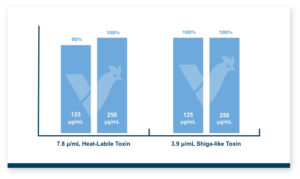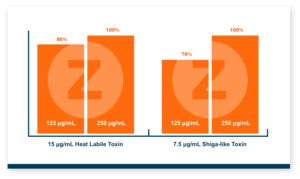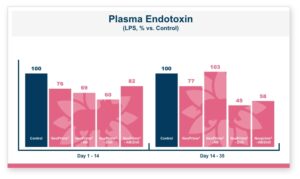Product availability may vary by country, associated claims do not constitute medical claims and may differ based on government requirements.
Bacterial pathogens such as Escherichia coli (E. coli) are a leading cause of enteric disease and economic loss for animal protein producers. Found readily in the environment of poultry and swine, E. coli can produce powerful toxins (exotoxins and endotoxins, see Figure 1) that damage the integrity and function of the intestinal barrier. These toxins cause inflammation, diarrhea and malabsorption that result in less gain, higher feed conversion and reduced performance. However, multiple studies have confirmed that natural mineral-based feed additives can provide an antibiotic-free method of reducing the negative production effects of E. coli toxins.

Figure 1: E. coli exotoxins are produced by the cell and secreted into the environment. Endotoxin (lipopolysaccharide, LPS) is released from the cell wall of E. coli or other gram-negative bacteria after the bacteria dies.
Powerful Toxins
Multiple E. coli strains produce potent exotoxins as part of their virulence package. These powerful toxins are major causes of enteric disease, particularly in neonatal and recently weaned animals. The toxins damage the intestinal lining, resulting in diarrhea, dehydration and even death.
Heat-Labile Enterotoxin
Enterotoxigenic E. coli (ETEC) — a common cause of porcine post-weaning diarrhea (PWD) and a source of diarrhea in poultry — produces the enterotoxin heat-labile toxin (LT). To exert its effects, LT is internalized by binding to surface receptors on the host intestinal mucosa.1 Once inside the cell, LT alters the electrolyte and water balance of the cell, which leads to diarrhea.1 A survey of U.S. ETEC isolates linked to porcine PWD showed that 57.7% had the heat-labile toxin gene.2
Shiga-like Toxin
E. coli types that produce shiga-like toxins are referred to as shiga toxin-producing E. coli (STEC). There are two types of shiga-like toxins (Stx1 and Stx2), and both have multiple subtypes. The mode of action for shiga-like toxin is inhibition of host cell protein synthesis that results in cell death.3 Edema disease (E. coli enterotoxemia) in swine is caused by shiga-like toxin (Stx2) subtype e.4
E. coli Endotoxin
The outer membrane of gram-negative bacteria such as E. coli or Salmonella contains lipopolysaccharides (LPS) which protect the bacteria from the environment. When the bacteria die naturally or as a result of using antibacterial products (e.g., antibiotics, specialized feed additives), endotoxin is released from the cell wall. Endotoxin causes specialized immune cells in the animal’s body to release high levels of cytokines that result in elevated temperature, weakness, tissue necrosis and, at high levels, death.
Management Programs to Control E. coli
With the global push toward antibiotic-free production, maintaining a healthy intestinal environment to reduce the risk of disease from E. coli now requires effective management strategies. Natural feed additives, tight biosecurity, effective sanitation, and good husbandry practices that protect the intestinal environment can all help control the risk of E. coli outbreaks.
Natural Mineral-Based Feed Additives Neutralize E. coli Toxins
The backbone of Amlan’s scientifically proven products is our natural mineral that undergoes proprietary thermal processing to optimize the efficacy of each product. Varium® (available in select international markets) for poultry and NeoPrime® (available in select international markets) for swine are species-specific formulations of three synergistic ingredients that improve feed conversion and intestinal integrity in poultry and maximize post-weaning performance in swine. Calibrin®-Z (available in select international markets) is a low-dose biotoxin binder for all species that actively defends the intestinal barrier against a broad spectrum of toxins produced by bacteria and fungi.
Adsorption of E. coli toxins by Varium and Calibrin-Z
The ability of Varium and Calibrin-Z to adsorb E. coli toxins was assessed in vitro by the United States Department of Agriculture Agricultural Research Service (USDA-ARS), Beltsville, MD. Calibrin-Z or Varium was added separately to each toxin, incubated to allow the toxin to bind, and then centrifuged to separate the free and bound toxins. The USDA researchers had developed a specific ELISA for heat-labile and shiga-like toxins, which was used to analyze the supernatant to quantify the presence of unbound toxins.
Varium and Calibrin-Z were both effective at neutralizing both exotoxins (Figures 2 and 3) and endotoxins. (Figure 4).

Figure 2: Varium neutralized E. coli exotoxins in vitro. Source: USDA-ARS, Beltsville, MD.

Figure 3: Calibrin-Z adsorbed E. coli exotoxins in vitro. Source: USDA-ARS, Beltsville, MD.

Figure 4: Varium and Calibrin-Z adsorbed E. coli endotoxin (LPS) in vitro. Calibrin-Z source: Gibraltar Laboratories, Fairfield, NJ. Varium source: USDA-ARS, Beltsville, MD.
NeoPrime Reduces Plasma Endotoxin Concentration
When endotoxin is released from dead gram-negative bacteria, it can damage the intestinal epithelial cells. Weakness in the intestinal barrier can lead to “leaky gut syndrome,” which allows the endotoxin to enter the blood stream. NeoPrime was assessed for its ability to strengthen intestinal integrity by analyzing the blood plasma endotoxin concentration of weanling pigs. Compared to a control that contained two antibiotics and zinc oxide, NeoPrime in multiple diet formulations reduced plasma endotoxin concentration from E. coli or other gram-negative bacteria (Figure 5).

Figure 5: Feeding NeoPrime decreased plasma endotoxins, indicating improved gut barrier function Source: Hunan Agricultural University, Hunan, China.
When to Use Our Mineral-Based Feed Additives
The research presented here supports in vivo studies showing that supplementation with Varium, NeoPrime or Calibrin-Z is an effective approach to reducing the effects of enteric disease in poultry and swine. To learn more about these natural mineral-based control methods for improving intestinal health and production efficiency, visit amlan.com or contact us at info@amlan.com.
References
- Duan Q, Xia P, Nandre R, Zhang W, Zhu G. Review of newly identified functions associated with the heat-labile toxin of enterotoxigenic Escherichia coli. Front Cell Infect Microbiol. 2019.
- Zhang W, Zhao M, Ruesch L, Omot A, Francis D. Prevalence of virulence genes in Escherichia coli strains recently isolated from young pigs with diarrhea in the US. Veterinary Microbiology. 2007;123:145–152.
- Melton-Celsa A. Shiga toxin (Stx) classification, structure, and function. Microbiol Spec. 2014;2.
- Baldo V, Salogni C, Giovannini S, D’Incau M, Boniotti MB, Birbes L, Pitozzi A, Formenti N, Grassi A, Pasquali P, Alborali GL. Pathogenicity of shiga toxin type 2e Escherichia coli in pig colibacillosis. Front Vet Sci 2020 Sep 18;7: n.p. doi: 10.3389/fvets.2020.545818.

